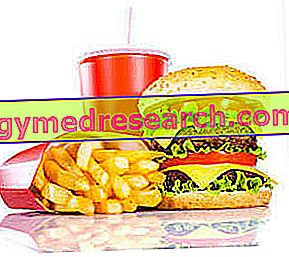Fast food, fast food in Italian, is a type of food distribution born in the Anglo-Saxon countries, which since the 1980s has spread rapidly in almost all over the world; fast food is a collective catering method (fixed or mobile) focused on the FAST production and administration of ECONOMIC foods, with a SUSTAINABLE cost for the average population.

The low nutritional value of food distributed in fast food, associated with a commercial strategy focused on optimizing profit, significantly compromises the healthiness of the meal, exposing consumers to risks of considerable importance.
paniniimbottiti (hamburgers and variants, hot-dogs, pita stuffed with kebabs, etc.), fried (croquettes, falafel, french fries, mozzarella, battered vegetables, crab claws, croutons, tortillas, etc.), pizzas and other baked goods, bruschetteria, stuffed tortillas (especially with fatty cold cuts, cheeses and sauces), sweet pastas (croissants, crafen etc.), sauces of all kinds (mayonnaise and creams, ketchup, mustard, mustard etc.), ice creams, cakes and muffins, etc. . Among these fast food foods, most are also considered junk food or junk food.
NB . Even carbonated and / or sweet drinks and beer are considered junk foods or junk food.
Risks inherent to fast food
The risks of fast food are numerous and concern different aspects of food hygiene:
- Risks of fast food linked to the nutritional quality of junk foods - junk foods
- Risks of fast food linked to toxic molecules
- Risks of fast food related to food poisoning
- Risks of fast food related to food education
- Risks of fast food linked to the incompetence of food workers
Junk foods - junk foods
The risks of fast food linked to "junk foods - junk foods" are numerous and a whole chapter would not be enough to describe them sufficiently. What is certain is that all forms of fast food do NOT have a suitable nutritional balance; this statement could be replied by stating that the suitability of each food in the diet must be evaluated based on the DAILY contextualization of meals. However, by carefully observing all the products mentioned above, it is quite clear that each of them possesses one or more negative characteristics such as:
- High energy density
- Low amount of water (drinks not included), few mineral salts and vitamins typical of fresh vegetables
- Considerable contribution of: saturated fat, hydrogenated fats and cholesterol; but also of sucrose and / or sweeteners, and alcohol
- Low amount of dietary fiber
- High ration of sodium chloride
- Low concentration of essential fats.
The risks of eating frequently with fast food are related to the increase in weight (adipose mass), to the potential alteration of lipid metabolism (hypercholesterolemia and hypertriglyceridemia), carbohydrate (hyperglycemia and diabetes) and blood pressure (prehypertension and hypertension), and to lack of vitamins, mineral salts and dietary fiber typical of fresh vegetables and fruits.
Toxic molecules
The risks of fast food caused by the high concentration of toxic molecules mainly concern the contamination from:
- Polycyclic aromatic hydrocarbons and related EPOSSIDES (hepatic metabolites)
- Acrolein and formaldehyde
- Acrylamide
Polycyclic aromatic hydrocarbons derive from the carbonization of fats and dietary proteins; they are dangerous for human health because they increase the risks of cellular DNA mutation causing CANCER especially in the esophageal, gastric, intestinal and hepatic tissues.
The acrolein and the formaldehyde instead are released ONLY from the combustion of the glycerol present in the fats: being volatile substances significantly increase the risks of: irritation of the ocular and nasal mosses, esophageal tumors and probably leukocemias .
Acrylamide is released by the carbonization of carbohydrates and also promotes the risks of carcinogenesis.
These molecules are released due to some types of cooking such as: frying, grilling and cooking on the grill, and are present both in fast-food foods, in the air of kitchens and / or restaurant rooms causing damage to both operator to the consumer.
NB . It should be noted that all the toxic catabolites indicated above, which significantly increase the risk of carcinogenesis, are enclosed in a single meal based on burgers and fries; on the contrary, low-balanced foods of Italian origin (piadine, sandwiches with salami, pizza, etc.) DO NOT significantly increase the aforementioned risks.
Food poisoning
In fast food there is a good chance of contracting some food diseases; in reality it would be more correct to speak both of infections, and of intoxications and toxinfections, since it is possible to fall ill both for the pathogenic bacteria (or virus) and for their toxins or both.
The risks of contracting these diseases are mainly linked to the consumption of NOT healthy foods, therefore contaminated (such as minced meat), which moreover do not reach sufficient cooking temperatures at the center of the food.
In this regard, some think (including unskilled food workers) that "good cooking" can sterilize foods making them harmless ... nothing more dangerous! We recall that ONLY the bacterial charge and the PROTEIC ESO-toxins can be destroyed by cooking [Gram positive bacteria (+)], while Gram negative bacteria (-) possess ENDO-LIPID toxins of thermoSTABLE membrane capable of giving food poisoning EVEN after death of the bacterium itself! Ultimately, a contaminated food always favors the risk of food poisoning and the fast food commercial policy ("low cost and high yield!") Can favor its distribution to the public and the contagion.
Food education
As if that were not enough, to accustom people (especially young and very young) to eat at fast food restaurants, is a diseducational factor that significantly increases all the risks mentioned above ... especially in the presence of food abuse (increasingly frequent). Children get used to very sweet, salty and "greasy" flavors, consolidating bad eating habits pursued also in home food.
Incompetence of food workers
A final observation deserves to be made on the specific knowledge and on the relative professional skills of the food workers who work in fast food restaurants. Let me be clear, with this paragraph we do not intend to make "all the grass a bundle", but rather to document a situation that is as widespread as it is worrying.
Working inside a fast food restaurant is not always a lifestyle choice and is more often a "forced" route; it can be deduced that, in addition to the lack of professional stimuli, nutritionists who work in a fast food restaurant do not have a specific vocational training BAG for this activity. By virtue of the Italian regulations in force (useful for reducing all the risks in the sector), kitchen and distribution operators are required to attend the "mandatory micro-courses" provided by the competent authorities which, in my opinion, absolutely cannot replace the course didactic by technical or professional hotel or similar institutes.
Unfortunately, the lack of essential notions on cooking, processing, preservation, cleaning, handling, food chemistry, etc. significantly contributes to increasing all the risks associated with the handling and marketing of food, worsening the wholesomeness (in itself questionable) of the widespread restaurants and fast food.
Healthy alternatives to fast food?
Our video recipes:
Sandwich light with bresaola
Crispy baked potatoes with little oil
Tortillas (corn chips) not fried
Soy and rice burger
Chickpeas Hamburger



